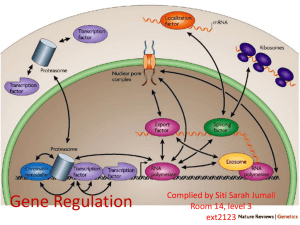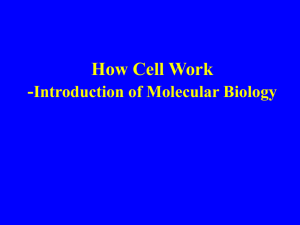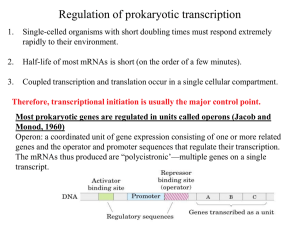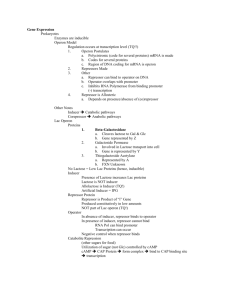Slides PPT
advertisement
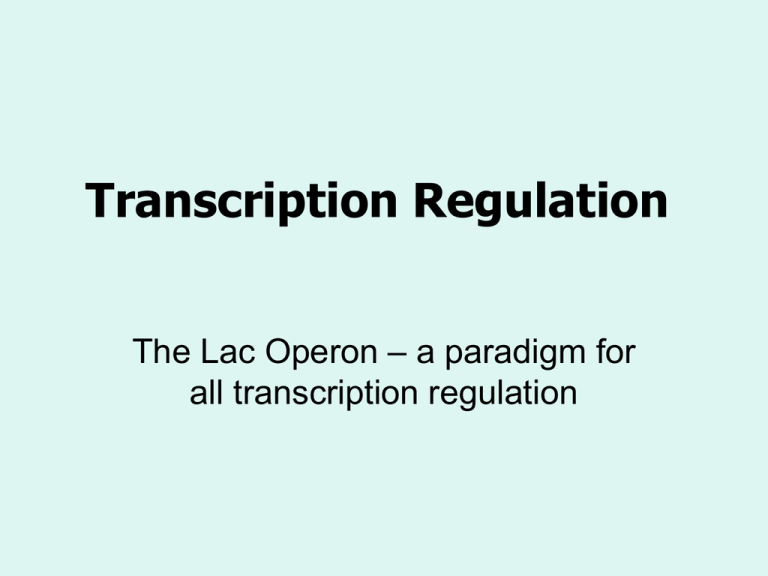
Transcription Regulation The Lac Operon – a paradigm for all transcription regulation Background: • E. coli (we are back with these pesky little coliforms) have the ability to grow in media which contain lactose as their sole carbon source. Lactose is a sugar found in milk (a disaccharide). • To metabolise this sugar the bugs must produce two enzymes, beta galactosidase and lac permease. • If the E. coli are grown up on media with other carbon sources there is very little activity of these two enzymes. Lactose CH 2OH CH 2OH O OH O O OH H reducing end OH H OH OH OH glucose galactose lactose Background: • The lac permease allows the lactose to enter the cell. • The beta galactosidase cleaves the bond joining the two monosaccharides (known as a beta galactoside bond, a type of glycosidic bond). • Once the sugar has been cleaved the two monosaccharides can be utilized by the cell’s glycolytic “house keeping” enzymes. Is this increase in enzyme activity a transcriptional event or simply an activation/deactivation of pre-existing enzyme activity? • The answer is it is a transcriptional event. To test for this a protein synthesis inhibitor is included in the incubation. The induction does not occur. (You will show this in the lab experiment). How does the presence of lactose, as the sole carbon source, control the level of transcription of the enzymes that catalyse its utilization? Two kinds of factors • Jacob and Monod were able to identify 2 different acting factors; cis and trans acting factors. • Cis acting factors only control transcription on the same piece of DNA • Trans acting factors influence transcription on other pieces of DNA The Lac Operon • They proposed a model containing the following elements; lac I, lac Z, Y and A. • The gene product of Lac I is a protein repressor, which binds to a region on the DNA known as the operator (-10 – 0) • There are only a few copies of the repressor in the cell and it binds as a tetramer. The Lac Operon • When the repressor is bound to the operator region it masks the -10 region of the promoter and prevents the binding of RNA polymerase to the promoter NO transcription. • The actual structural genes are lac Z (beta galactosidase), Y (lac permease) and A (lac acetylase). • These three genes are all transcribed in one long mRNA, known as a polycistronic mRNA. How does it work? • The lac operon is under two forms of control; positive and negative control. • Negative control occurs when the binding of a protein prevents an event. The brake on the car • Positive control is when the binding causes the event. The accelerator on the car. Negative control • The lac repressor (product of gene lac I) is negative control. • When lactose is absent the repressor is bound to the operator preventing RNA polymerase binding NO transcription. • End Result: when there is no substrate you don’t make the enzyme. What happens when lactose enters the cell? • A small amount of it is converted to allolactose (this is NOT a substrate for beta galactosidase) • The allolactose then binds to the repressor • The repressor: allolactose complex dissociates from the operator • Transcription can begin. Positive Control • This is exerted by a protein known as the Catabolite Activator Protein (CAP) • This protein binds to a site on the DNA within the promoter region and increases the rate of RNA polymerase binding; hence transcription initiation. • It only does this when complexed to cAMP. What is cAMP? • This is a compound synthesised from ATP by adenylyl cyclase which acts in both eukaryotes and prokaryotes as a second messenger. • In this situation cAMP ↓ when glucose enters the bacterial cell • This causes the cAMP associated with CAP to come off CAP without cAMP then comes off the DNA Putting it all together • When lactose is present the repressor is off the operator. • When glucose is present the CAP is off the promoter. Different Scenarios 1. 2. 3. 4. Lactose (+) and glucose (-) Lactose (+) and glucose (+) Lactose (-) and glucose (+) Lactose (-) and glucose (-) Scenario 1 Lactose (+) glucose (-) • Some of the Lactose entering the cell via the few lac permease transporters available has been converted to allolactose and has resulted in the removal of the repressor from the operator. Scenario 1 Lactose (+) glucose (-) • • The promoter is now unmasked and RNA polymerase can now bind and initiate transcription. However it won’t do this very frequently without the help of the cAMP-CAP bound to the activation site. Scenario 1 • • This protein complex binding puts a 90o kink in the DNA and interacts with the alpha subunit of RNA polymerase. Without the cAMP:CAP the lac promoter is a weak promoter varying significantly from the consensus sequence at -10 and -35. The combination of the two controls means beta gal and lac permease are transcribed at high levels. Scenario 1 • • • • Lactose (+) glucose (-) Repressor with allolactose bound is now off the operator and the CAP with cAMP bound is on the DNA in a region upstream from the promoter. The RNA pol can bind to the promoter and the CAP:cAMP can act positively to enhance the frequency of transcription initiation. Brake off accelerator on Scenario 2 Lactose (+) and glucose (+) • The repressor is off the operator but the CAP protein (without cAMP) is not bound to the DNA so initiation only occurs at a low rate little transcription. • Brake off but accelerator off also Scenario 3 Lactose (-) and glucose (+) • The repressor is bound to the operator and the CAP (without cAMP) is not bound to the DNA. Very little transcription of the lac operon genes is happening now. • Brake on and accelerator off…not going anywhere fast Scenario 4 Lactose (-) and glucose (-) • The cell is starving! The repressor is on the operator but the cAMP CAP is on the DNA. If the repressor is bound there is no transcription RNA polymerase has no access. • Brake on and accelerator on (but you have run out of petrol!) Terms • • • Negative and Positive Control Cis and Trans acting factors Global and Specific regulation. Global Regulation • • A factor can influence the transcription of a number of genes scattered throughout the genome e.g. CAP. A number of genes which encode catabolic enzymes involved in carbohydrate metabolism are controlled by CAP e.g. arabinose operon Specific Regulation • • A factor can influence the transcription of a few genes downstream e.g. lac repressor Only the next string of genes in the operon, which are transcribed to a single polycistronic meassenger RNA will be affected. Other Operons • • • The most famous is the Trp operon. The 5 enzymes which synthesise tryptophan are encoded on genes TrpE – TrpA. These genes are switched OFF when there is high [trp] in the cell and switched ON when [trp] is low. Trp Operon • • • • The opposite to the Lac Operon. Because the enzymes are anabolic. The trp repressor binds to the operator DNA when the trp is bound. When the trp dissociates from the repressor i.e. when intracellular trp falls, the repressor comes off the operator and transcription can begin.
